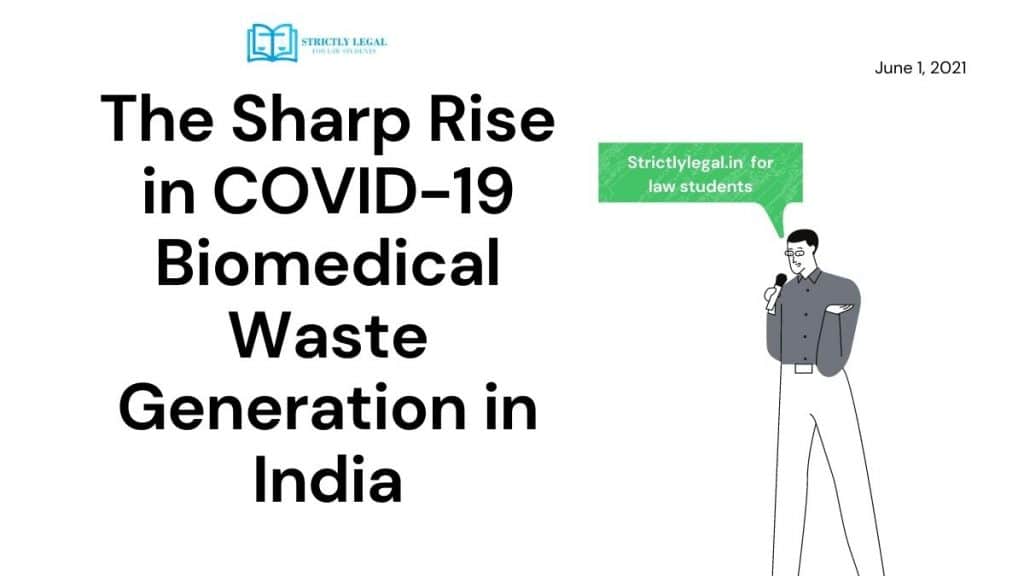Healthcare waste is the second kind of most hazardous waste all across the world. It consists of things like human body parts, tissues, blood, sharps, chemical waste, medical device like syringes, and pharmaceutical wastes. This kind of waste is produced mostly by hospitals, health care facilities, morgues, laboratories, nursing homes, and blood banks. The generation of this waste happens when there is some kind of treatment or diagnosis or research which leads to the production of biomedical waste. If this waste is not managed properly, then it can lead to the outbreak of human diseases, and thereby proper management should be done to ensure there are no harmful impacts on human health and the environment.
This blog has been written by Jahnnavi Sarkhel, 11th Semester student of B.A. LL.B. (Hons.) course at Hidayatullah National Law University
Coronavirus disease or the COVID-19 has its roots in the SARS-CoV-2 virus. This causes respiratory disease and was first reported in December 2019 in the city of Wuhan in China. COVID-19 has been deemed as a Public Health Emergency of International Concern and has spread to almost all countries worldwide. This pandemic has put a severe strain on the public healthcare system across the world, the rapid increase in infected patients and the disease being highly transmissible, has led to a high number of hospitalizations. As a result of this, the amount of solid waste generation has also increased. The use of PPE kits or personal protective equipment by frontline workers during the pandemic has increased drastically as compared to normal situations and this too has increased biomedical waste. Therefore, this calls for an increased capacity to handle healthcare in a better way as improper management of this kind of waste will lead to the further spread of the virus.
In India Biomedical Waste Management Rules 2016 and the Amendment Rules of 2018 manage the handling of BMW. India is the second-most populous country in the world and it is the nation that has been hit worst by the pandemic. India faces a lack of resources and a flawed system of handling BMW. Proper handling of this kind of waste can prevent cases of hospital-acquired infection and reduce the transmissibility of this disease.
Table of Contents
Impact of COVID-19 on waste in India
The Coronavirus belongs to the family called Coronaviridae in the order called Nidovirales. This family has a sub-family called the Orthocoronavirinae and this includes the types alpha, beta, and gamma, and delta coronavirus. Two viruses, SARS and MERS belong to the beta category and they were first detected in 2002 and 2012 respectively. The present, deadly, coronavirus belongs to the family of beta coronavirus. The traces of this virus was first found in 2019 in the city of Wuhan, China, and rapidly spread to other nations across the globe and the World Health Organization (WHO) declared this virus a pandemic. Various epidemiological studies show three kinds of conditions that are required for the spread of the virus, infection source, transmission route, and susceptibility. The infection can spread from one person to another through close contact, contact with infected surfaces, and waste that has been generated from infected persons and places. This is the reason why the waste which has been generated from hospitals and health care centers should be handled with extra care as infected waste might lead to harm to humans due to the spread of the virus. It is very important that proper action should be taken when it comes to storing, collecting, and handling, transporting, and disposing of this kind of waste.
Biomedical Waste
Waste is something that is not useful anymore to the owner. One of the kinds of waste is solid waste. This solid waste is categorized into municipal, hospital, and agricultural, etc. the waste which is generated from healthcare settings is called biomedical waste. This can include sharps waste like needles, blades, and syringes, pathological waste like fluids and tissues, and other infectious waste like contaminated gloves and bandages. It can also include pharmaceutical waste like expired drugs, radioactive waste like radioactive packaging and glassware, and chemical waste like disinfectants and chemical substances.
Treatment of Biomedical Waste in India during the COVID-19 Pandemic
One of the essential ways to respond to this pandemic is to make sure solid waste is managed properly. The biomedical waste generated from the health care sector is 517 tonnes per day just in India. The pandemic has increased the waste generated normally by 15 times.
There are various methods to treat this kind of waste and one of them is incineration where the combustible waste is burned under controlled circumstances by using fuel like kerosene. Another process is using autoclaves which is a steam-based treatment system where a specific amount of heat and pressure is used to make sure infected and contaminated waste are inactivated. Irradiation is another method that uses microwaves and UV rays to help destroy harmful microorganisms. This method can supplement other waste disposal methods and are not available in low and middle-income countries.
Compost and burial are biological methods that rely on a natural decomposition of organic matter. It is usually used for human waste like placentas. There are mechanical methods used too, like shredding, mixing, and compacting, which helps to reduce the volume of waste but these methods do not eliminate the microorganisms and are usually used to substitute other methods. This method is used to dispose of syringes and needles but only after these are disinfected.
Challenges Unique to India
The challenging issues faced by India when it comes to collecting biomedical waste generated during COVID-19 are:
- The quantity of domestic hazardous waste (DHW) has increased significantly. This includes things like head covers, masks, and gloves. There is a lack of collecting this kind of waste separately.
- Staff and sanitary workers are not trained properly to handle the waste generated.
- Improper supply of PPE kits and disinfectants can increase the exposure of waste collection staff to the virus.
- People hardly maintain proper social distancing as per the guidelines in the collection centers and treatment plants.
- The water discharged from the health care centers may be infected with the virus, the waste management staff can be exposed to it if they are not properly protected.
- In several areas across the country, door-to-door waste collection is not practiced. Instead, there is the system of one-point collection and this increases the risk of getting infected as the residents gather in a single place in large numbers.
- There need to be separate vehicles for collecting COID-19 waste and these vehicles should be disinfected regularly to ensure the workers do not get infected.
Solutions
The following are the suggestions given to improve the system of collection and disposing of biomedical waste:
- The DMW needs to be kept in yellow bags which are provided by the Urban Local Bodies or the ULBs. These bags should not be mixed with other kinds of wastes when storing is done in households and collection is done by the collection authority.
- The yellow bags should be such that they do not cause leakage and they should be kept away from pets and children.
- Masks, head covers, gloves, and PPE kits that are generated as waste from homes should be kept idle in paper bags for 72 hours straight before it is disposed of as general waste or before it gets handled by sanitary workers.
- A separate team of sanitary workers should be assigned to collect COVID-19 waste.
- The COVID-19 waste should only be handed over to an authorized collector or these yellow bags should be disposed of at designated centers.
- The Local Bodies should provide yellow bags and their assistance to the people who operate quarantine centers and people who are at home taking care of affected patients.
- The sanitary workers should be provided with enough PPE kits and they should wear them at all times and must sanitize these kits.
- The people at the collection centers and treatment plants should maintain a distance of 6 feet apart from each other at all times.
- People who show symptoms of COVID-19 should not be around people and go to work. They should inform the concerned people about their condition.
- The vehicles which are used to collect the waste should be sanitized regularly with chemicals and disinfectants like sodium hypochlorite.
- Proper washing of hands and face should be maintained and it should be ensured no one touches their eyes, nose, and mouth.
- Staff should be daily checked before and after their work shift.
Conclusion
The high rate of infection is rapidly increasing the volume of biomedical waste. The waste might be contaminated with the virus and might infect the sanitation workers as they are directly exposed to it. To prevent this spread of infection and to put a curb on it, the COVID-19 waste should be disposed of properly, the waste should be segregated, disinfected, and treated on-site before the workers handle the waste. Proper training of the staff and providing them with PPE kits is also essential. Therefore, proper health care infrastructure and waste management are very important to help stop the spread of COVID-19.

Users not registered with Strictlylegal can Email us their content and the same are posted through this account. In case of abuse, kindly let us know at [email protected]




